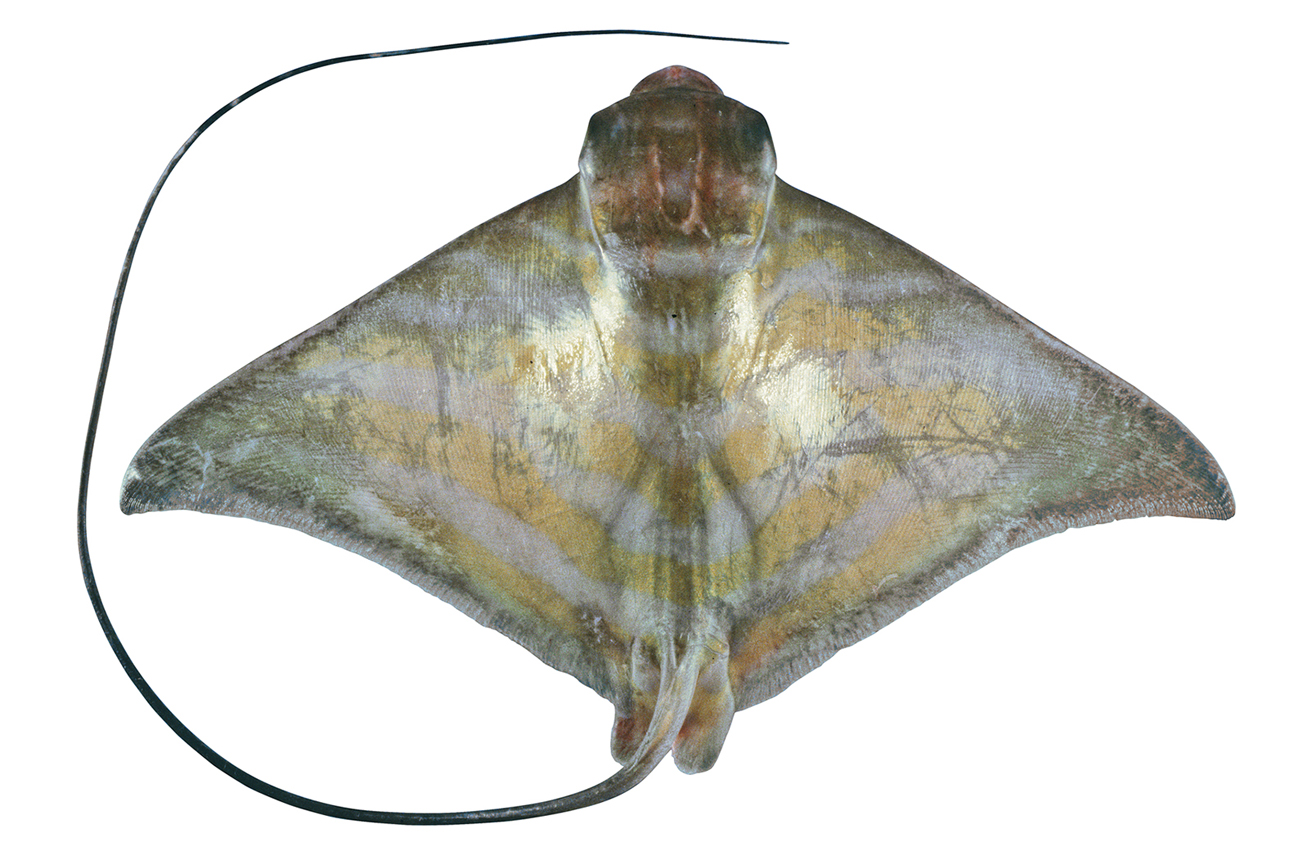- Classification
- CHONDRICHTHYES
- MYLIOBATIFORMES
- MYLIOBATIDAE
- Aetomylaeus
- caeruleofasciatus
Blue-banded Eagle Ray, Aetomylaeus caeruleofasciatus (White, Last & Baje 2015)
Other Names: Banded Eagle Ray, Barbless Eagle Ray

Paratype (juvenile) of the Banded Eagle Ray, Aetomylaeus caeruleofasciatus, from north of Joseph Bonaparte Gulf, Western Australia - CSIRO CA 1254, male 230 mm DW. Source: Australian National Fish Collection, CSIRO. License: CC BY Attribution-Noncommercial
Summary:
A greenish to yellowish-brown eagle ray with seven pale bluish bands (sometimes faint) across the disc, without dark spots or blotches, a whitish underside, pectoral fins usually not dusky distally, and a rather long tail without a stinging spine.
In Australia, this species was previously called Aetomylaeus nichofii which does not occur in Australia or New Guinea.
In Australia, this species was previously called Aetomylaeus nichofii which does not occur in Australia or New Guinea.
Cite this page as:
Bray, D.J. 2020, Aetomylaeus caeruleofasciatus in Fishes of Australia, accessed 27 Apr 2024, https://fishesofaustralia.net.au/home/species/4286
Blue-banded Eagle Ray, Aetomylaeus caeruleofasciatus (White, Last & Baje 2015)
More Info
|
Distribution |
Dampier Archipelago, Western Australia, to Hervey Bay, Queensland. Also occurs in New Guinea, with records from Freshwater Bay in the Gulf of Papua and Orangerie Bay. Inhabits areas with soft substrates in inshore and continental shelf waters at depths to 117 m. |
|
Features |
A small Aetomylaeus (attaining about 590 mm DW) with the following combination of characters: dorsal surface greenish to yellowish brown with a series of seven transverse pale bluish bands (sometimes faint), without dark spots or blotches; ventral surface whitish, pectoral fins usually not dusky distally; tail rather long (1.5–1.8 times DW); no stinging spine; head short and narrow; rostral lobe fleshy, relatively broad, short, with a rounded apex; teeth in seven rows in each jaw, with a broad median row flanked by three smaller rows on each side; dorsal-fin origin level with pelvic-fin insertions; pectoral-fin radials 84–88 (excluding concealed propterygial radials anterior of eyes); total vertebral centra (including synarcual) 80–86; males with 14 or 15 pelvic radials (excluding clasper); females with 20 or 21 pelvic radials; males mature by 434 mm DW. |
|
Feeding |
Feeds on bony fishes and a range of benthic invertebrates including worms, crustaceans and molluscs. |
|
Biology |
Aplacental viviparous (ovoviparous), with embryos feeding initially on yolk, then indirectly absorbing uterine fluid from the mother that is enriched with mucus, fat or proteins. Females give birth to about 4 pups that are born at 17 cm DW (disc width). |
|
Fisheries |
In Australia, the species is caught and discarded as bycatch in the Northern Prawn Fishery and in the Queensland East Coast Trawl Fishery. It is also taken in low numbers in the Gulf of Papua prawn trawl fishery. In northern Australia, the compulsory use of turtle exclusion devices has reduced the capture of rays. |
|
Similar Species |
Aetomylaeus caeruleofasciatus differs from A. nichofii in the number of pelvic radials in males (14 or 15 vs. 16–19, excluding clasper and first enlarged element) and females (18 or 19 vs. 20 or 21, excluding first enlarged element). The two species have a similar colour pattern, but A. nichofii often has an eighth bluish band present on the dorsal surface, with the seventh band being slightly more anteriorly positioned and the eighth band present as a narrower, less distinct band. The blue bands may also be less distinct in adults of A. nichofii than in A. caeruleofasciatus (although more freshly caught individuals need to be examined to determine if this is a useful character). |
|
Etymology |
The specific name is from the Latin caeruleus (= blue) and fasciatus (= band) in reference to the distinctive transverse blue bands present on the dorsal surface of the disc. |
|
Species Citation |
Aetomylaeus caeruleofasciatus White, Last & Baje 2015, Ichthyol. Res.: Figs 2–5a, 6, 7, 11, 12. Type locality: Bay south of Eagle Point anchorage, Western Australia, 16°14.73'S, 124°23.71'E, depth 10-15 m, adult male. |
|
Author |
Bray, D.J. 2020 |
|
Resources |
Blue-banded Eagle Ray, Aetomylaeus caeruleofasciatus (White, Last & Baje 2015)
References
Allen, G.R. 1997. Marine Fishes of Tropical Australia and South-east Asia. Perth : Western Australian Museum 292 pp. 106 pls. (as Aetomylaeus nichofii)
Allen, G.R. & Swainston, R. 1988. The Marine Fishes of North-Western Australia. A field guide for anglers and divers. Perth, WA : Western Australian Museum vi 201 pp., 70 pls. (as Aetomyleus nichofii)
Blaber, S.J.M., Brewer, D.T. & Harris, A.N. 1994. Distribution, biomass and community structure of demersal fishes of the Gulf of Carpentaria. Aust J Mar Freshwat Res 45: 375–396. (as Aetomyleus nichofii)
Blaber, S.J.M., Young, J.W. & Dunning, M.C. 1985. Community structure and zoogeographic affinities of the coastal fishes of the Dampier region of north-western Australia. Aust J Mar Freshwat Res 36: 247–266. (p. 259 as Myliobatis australis)
Brewer, D., Heales, D., Milton, D., Dell, Q., Fry, G., Venables, B. & Jones, P. 2006. The impact of turtle excluder devices and bycatch reduction devices on diverse tropical marine communities in Australia's northern prawn trawl fishery. Fisheries Research 81: 176-188.
Compagno, L.J.V. & Last, P.R. 1999. Families Gymnuridae, Myliobatidae, Rhinopteridae, Mobulidae. pp. 1505-1529 in Carpenter, K.E. & Niem, V.H. (eds). The Living Marine Resources of the Western Central Pacific. FAO Species Identification Guide for Fisheries Purposes. Rome : FAO Vol. 3 pp. 1397-2068. (as Aetomylaeus nichofii in part : p. 1514, p. 1517, fig. (northern Australia and New Guinea)
Gloerfelt-Tarp, T. & Kailola, P.J. 1984. Trawled Fishes of Southern Indonesia and Northwest Australia. Jakarta : Dir. Gen. Fish. (Indonesia), German Tech. Coop., Aust. Dev. Ass. Bur. 406 pp. (as (as Aetomylaeus nichofii p. 44, in part – Area C record)
Last, P.R. & Stevens, J.D. 1994. Sharks and Rays of Australia. Canberra : CSIRO Australia 513 pp. (as Aetomylaeus nichofii)
Last, P.R. & Stevens, J.D. 2009. Sharks and Rays of Australia. Collingwood : CSIRO Publishing Australia 2, 550 pp.




